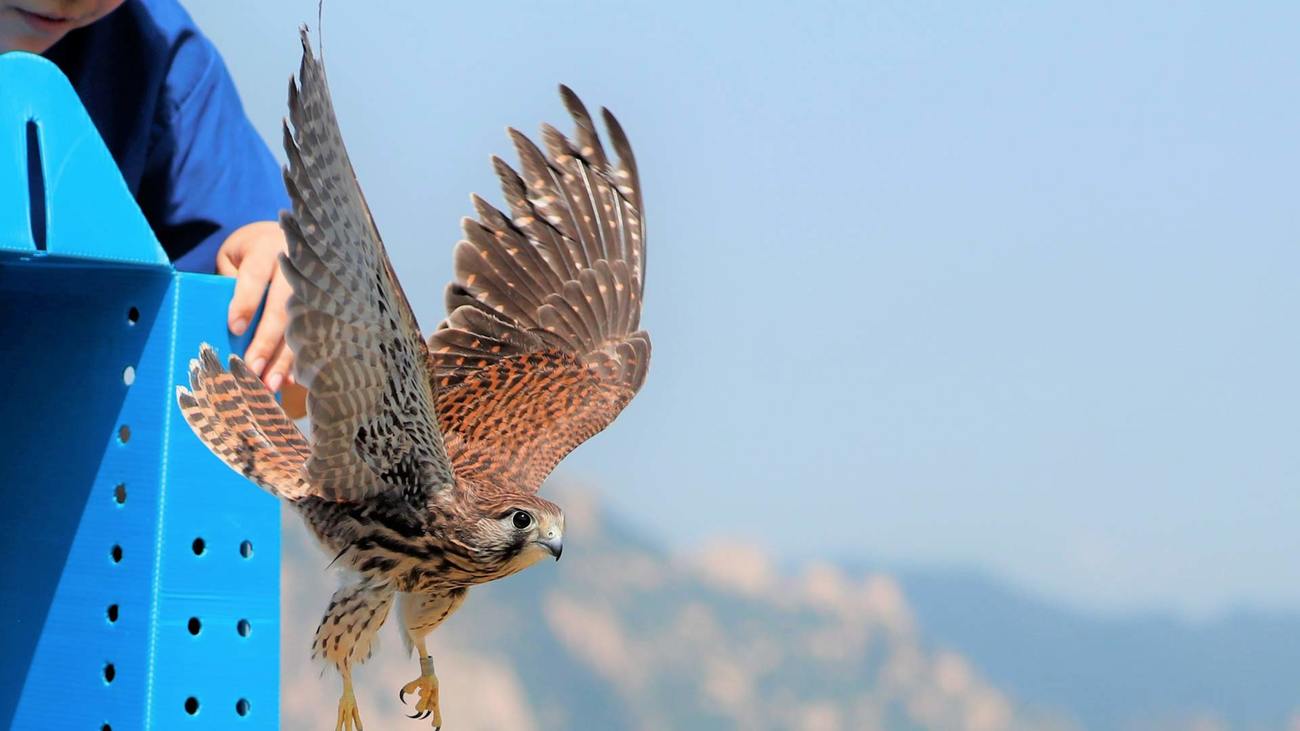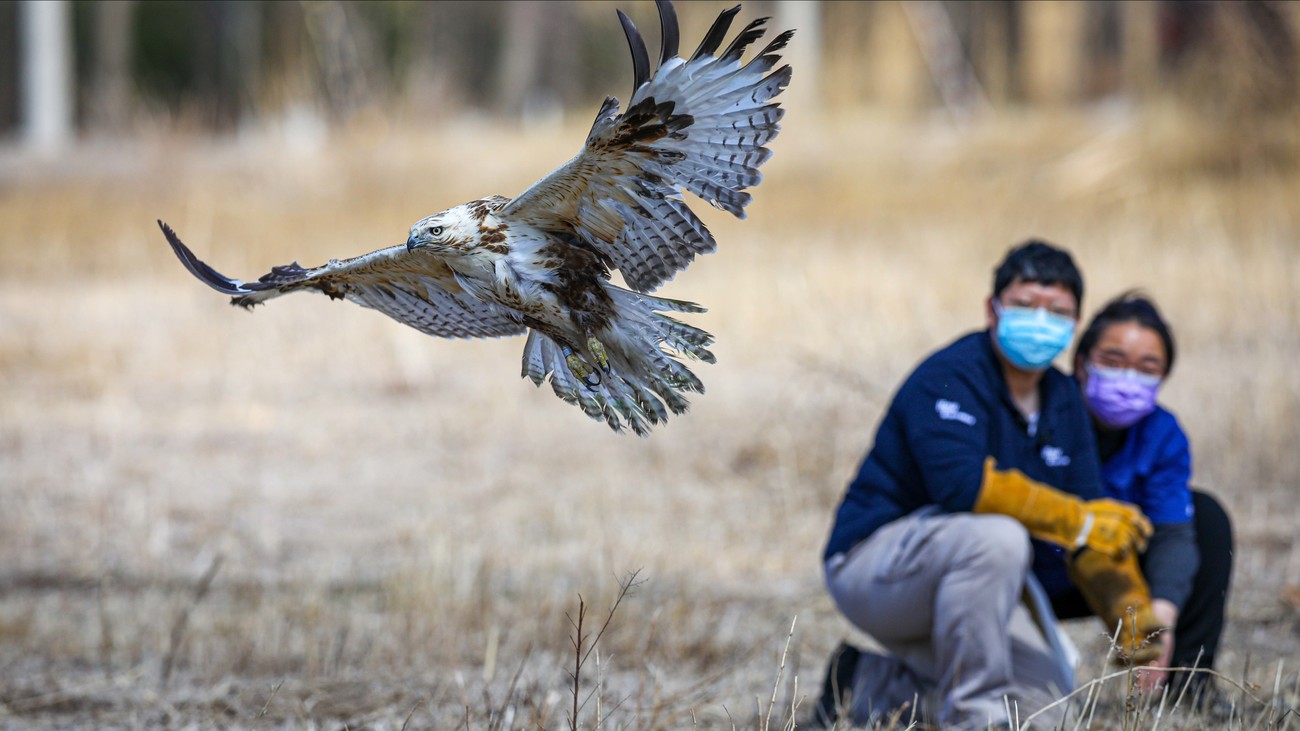Beijing Raptor Rescue Center - China
Birds of prey are falling prey in Chinareflections on the 20th anniversary of the Beijing Raptor Rescue Center
reflections on the 20th anniversary of the Beijing Raptor Rescue Center

On a chilly winter afternoon in 2001, with a cardboard box in my hand, a group of us climbed onto a hill overlooking Beijing. The sun was about to slip behind the trees. The only sound was our feet crunching on the dry leaves. “This is a good spot,” someone whispered as we came to a landing. A stone ledge overhung the hillside. Behind us was a small forest of trees. I put the box on the ledge, carefully turned on its side with the opening away from me, and quietly opened the flaps. A small eagle owl jumped out, hopped a few steps, and turned around. Before flying into the trees, he locked his eyes with mine for a moment.
I was overcome with emotions. Many firsts happened in that brief moment. The eagle owl was the first patient released from China’s first raptor rescue facility. For the first time, animal welfare was considered in returning a wild raptor back to the sky. Releasing the nocturnal bird at dusk, we gave him the best chance to get familiar with his new surroundings, catch prey and survive in the wild. Watching the eagle owl taking flight that day, I remembered the motivation that drove me to establish the Beijing Raptor Rescue Center (BRRC) in the first place.

Creating BRRC
In the winter of 1998, the media reported that Chinese Customs officials made a series of seizures of raptors from illegal trade. One of the seizures at Beijing International Airport involved nearly 400 saker falcons. Saker falcons are medium-sized migratory birds ranging from central Europe to China. The smuggled birds were packed together in suitcases, each with its eyelids sewn shut and stuffed in pantyhose, on their way to the Middle East. Unfortunately, there was no professional raptor rescue center to save them. What’s more, I was shocked to see people with good intentions bring irreparable harm to animals. I went to a so-called bird release touted to “raise public awareness that birds should be protected.” What I saw was the lives of birds of prey sacrificed for a photo op. Six celebrities, each holding a sickly raptor, stood amongst a rambunctious crowd. On the count of three, with the crowd cheering and the cameras flashing, they threw the dazed birds, including four owls, into the air. All of the birds promptly dropped to the ground. Watching the birds’ lifeless bodies, I felt my heart breaking.
“IFAW has to have a model to demonstrate animal welfare standards in wild animal rescue, rehabilitation and release,” I thought. From that moment on, I was determined to make it happen.
I approached the Beijing Normal University (BNU), well-known for its ornithological research. The professors at BNU enthusiastically embraced the idea. In addition to providing expertise, BNU offered space in a quiet corner on campus in central Beijing. Together, we accomplished a groundbreaking achievement for China: the first raptor rehabilitation center.

Overcoming challenges and advancing techniques
Twenty years have passed in the blink of an eye, and the Beijing Raptor Rescue Center continues to grow and progress.
In 2010, we obtained our first respiratory anesthesia machine. In past years, the rehabilitators needed to hold the raptors while taking the X-ray, and sometimes need to move raptors back and forth to take X-ray during an operation. The respiratory anesthesia machine not only spared rehabilitators the need to wear a 10-kilogram lead protection gear during X-ray, but also helped the rehabilitators to treat raptors in a safer and more efficient manner. That year, we also made progress on treating bone fracture in raptors, despite some of raptors’ bones being as thin as toothpicks.
In 2014, automatic spray devices were installed in the outdoor enclosures to help birds of prey cool down in the summer. Since then, rehabilitators no longer need to stand in the sweltering heat holding water hoses to manually cool the bird cages.
In 2016, we purchased a constant temperature operating bed to prevent birds of prey from losing heat during surgery. Before that, rehabilitators had to use a hot water bottle to keep the raptors warm during operations. That year, we also upgraded the raptor cages with wood. In the front half of the cage, birds can see each other through the slats between the wooden planks, so young raptors can observe and learn behavior from mature birds. The back half of the cage remains fully enclosed, giving the birds privacy if they so choose.
Along with upgrading hardware, BRRC rehabilitators have also been continuously learning new skills and applying the most advanced bird rescue techniques in their daily work. They provide professional treatment and around-the-clock care to every bird of prey that comes into the center.
BRRC’s impact on conservation
Since releasing our first eagle owl 20 years ago, more than 5,500 raptors from 39 different species have come into BRRC. More than 54% of them have been returned to the sky. To ensure their long-term survival, we have also instituted post-release monitoring. A GPS tracker on a released upland buzzard on March 27, 2018, shows that it has managed to live in Mongolia for several breeding seasons.
In addition to healing the individual raptors, the BRRC rehabilitators share their expertise and promote animal welfare at every rescue, in every media story and at every school event. They share their experiences and knowledge with peer rehabilitators around the country, improving the overall standards of care for birds of prey and jointly promoting the protection of raptors in China.

A growing value for wildlife welfare
BRRC’s accomplishments are also attributable to a more eco-friendly social environment and an enlightened public that increasingly embraces the concepts of animal welfare in wildlife rescue.
Many of the rescuers now have learned to provide basic first aid to raptors in need before the rehabilitators arrive. In a recent case where a hotel manager found a long-eared owl motionless inside the building,she immediately put the injured raptor into a cat carrier, covered it with a towel and put it in a quiet corner. Her quick thinking effectively reduced further stress to the animal, ensuring the long-eared owl could return to the wild in a short time.
In the early years of BRRC, when rehabilitators responded to rescue calls, the question they were asked most often was, “Is this bird edible?". With the rising public awareness about animal protection, today, the question our rehabilitators hear most often is, "Is this bird endangered? Please try to save its life."
In the past 20 years, BRRC has made impacts in combatting wildlife crime and enhancing policies for the harmonious coexistence of people with wildlife. We firmly believe that wildlife belongs in the wild, and we are proud to see our work influencing agencies and their wildlife policies.
We are eager to see what the future brings for BRRC and will continue to do everything we can to give rescued raptors a second chance in life.
-Grace Ge Gabriel, IFAW Asia Director
Related content
Every problem has a solution, every solution needs support.
The problems we face are urgent, complicated, and resistant to change. Real solutions demand creativity, hard work, and involvement from people like you.